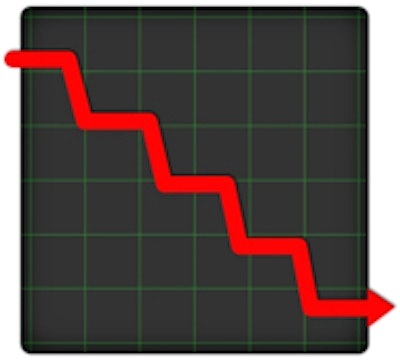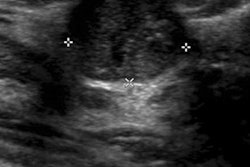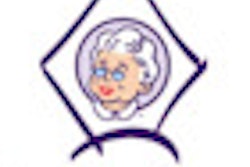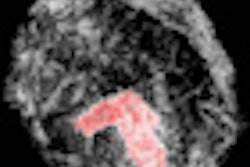
Minnies winners, page 2
Best Radiologist Training Program
Winner: Johns Hopkins University, Baltimore, MD
Johns Hopkins University is a perennial favorite in the Minnies voting for the Best Radiologist Training Program, reflecting the institution's stellar reputation in the radiology community.
This year, the diagnostic radiology residency program at the university's Russell H. Morgan department of radiology and radiological science again grabbed top honors. The program handles nine to 10 residents per class, with the goal of training "superb radiologists who will be future leaders," according to the program's website.
 Johns Hopkins takes home Best Radiologist Training Program win.
Johns Hopkins takes home Best Radiologist Training Program win.In May 2012, Johns Hopkins completed an ambitious new expansion that replaced half the original hospital with two new 12-story patient-care towers that occupy five acres of the university's medical campus in east Baltimore. The Sheikh Zayed Tower for adult care and the Charlotte R. Bloomberg Children's Center also include new imaging technology, such as an expanded radiology suite in the adult emergency department (ED) that includes an MRI scanner for use in the ED.
Among the notable faculty at Johns Hopkins are Dr. Elliot Fishman, Dr. David Yousem, Dr. John Carrino, and Dr. Richard Wahl, while former department chair Dr. Elias Zerhouni served as head of the U.S. National Institutes of Health (NIH) from 2002 to 2008.
Dr. Stanley Siegelman, who for many years ran the university's residency program and also was director of radiology, maintains a presence through video lectures in the department's interactive online education program, which features courses taught by Hopkins faculty that are derived from the resident training program.
Today, the department is led by Dr. Jonathan Lewin, while Dr. Karen Horton is director of radiology residency. Horton believes that both leadership from the top and the high quality of the program's residents have helped the department maintain its leadership position.
"The key to our success at Hopkins is unwavering support from our chairman, Dr. Lewin; dedicated, passionate faculty; and, of course, exceptional residents," Horton said.
Runner-up: Duke University, Durham, NC
Best Radiologic Technologist Training Program
Winner: Weber State University, Ogden, UT
Weber State University has made frequent appearances in the Minnies but never claimed the top honor. That dry spell has now ended, with the university winning Best Radiologic Technologist Training Program.
From its roots as a hospital-based radiography program, Weber State's radiological sciences department has evolved to offer three levels of education, with associate, bachelor's, and master's degrees. The department employs eight faculty, seven adjunct faculty, and three office staff.
 |
| Weber State named Best Radiologic Technologist Training Program. |
The department touts a pass rate on national certification exams of 95% or better, and 200 students study in its Bachelor of Science program. A highlight of the department is its regional program, which allows students to gain experience from clinical sites in their own communities, working in more than 50 clinical sites in Utah and neighboring states.
Weber State launched a Master of Science in Radiologic Sciences (MSRS) program in 2010, becoming one of the first universities in the U.S. to do so. The program enables technologists to focus on education and research, or on advanced clinical practice. The first MSRS graduating class of 24 students completed the program in 2012, and the program has now grown to 50 students.
Department chair Robert J. Walker, PhD, believes that the department's success is due to a simple formula.
"We provide the best: the best education for our students, the best support for our faculty, the best resources for our healthcare partners, and the best partnership with our community," Walker said.
Runner-up: Johns Hopkins University, Baltimore, MD
Most Significant News Event in Radiology
Winner: Supreme Court upholds healthcare reform legislation
The biggest news event in healthcare this year was also ranked by our expert panel as the Most Significant News Event in Radiology in the 2012 Minnies: the U.S. Supreme Court's decision to uphold the Obama administration's healthcare reform plan, the Patient Protection and Affordable Care Act (PPACA).
 U.S. Supreme Court upholds healthcare reform.
U.S. Supreme Court upholds healthcare reform.The Supreme Court's decision, handed down in June, shocked many in the political world as well as those in the radiology industry, who had anticipated that a court leaning conservative would choose to throw out or water down the law, in particular its controversial requirement that all U.S. citizens purchase healthcare insurance. But Chief Justice John Roberts, perhaps mindful of his court's legacy, cast the swing vote in favor of upholding the law by joining with the court's more liberal wing.
With legal challenges swept aside, the Obama administration is now moving ahead with implementing the law; however, former Massachusetts Gov. Mitt Romney has vowed to dismantle Obamacare if he wins the presidential election in November. Most industry observers don't believe the law on its own will significantly affect radiology; in fact, the U.S. government is likely to continue its pressure on Medicare reimbursement under either an Obama or Romney administration.
Runner-up: FDA moves forward in regulating CT radiation dose
Biggest Threat to Radiology
Winner: Decline in Medicare and third-party reimbursement rates
The steady decline in reimbursement for medical imaging procedures has dominated headlines in radiology in recent years, and 2012 was no exception, with the Minnies panel voting this issue as the Biggest Threat to Radiology.
Concern over falling payments was great enough to trump the issue that has concerned Minnies expert panelists in the past: the increased use of medical imaging by physicians in other specialties (turf battles).
 Declining reimbursement voted Biggest Threat to Radiology.
Declining reimbursement voted Biggest Threat to Radiology.Most of the heat has been coming from the U.S. Centers for Medicare and Medicaid Services (CMS), which has been steadily applying pressure to reimbursement for advanced diagnostic imaging using a variety of tools. The biggest cut came with the Deficit Reduction Act (DRA) of 2005, but recent years have seen other reductions, such as changes in the equipment utilization rate, as well as the expansion of the multiple procedure payment reduction (MPPR). And to the chagrin of radiology providers, cuts implemented by Medicare are often put into effect by third-party payors.
The payment reductions are seen by many industry observers as the root cause of the malaise that has affected medical imaging since the Great Recession first began in 2008. They also appear to have contributed to a tectonic shift in the very nature of radiology employment, with the rising influence of hospitals and national teleradiology-based companies at the expense of the private radiology groups that have been the backbone of the specialty since its inception.
Organized radiology continues to fight back against new reimbursement cuts, with many pointing to the fact that imaging procedure volume has declined markedly since 2006 -- a sign that further cuts are unnecessary, they claim. However, pressure on payment rates will continue as long as healthcare spending consumes a rising share of the U.S. gross domestic product.
Runner-up: Increased use of medical imaging by physicians in other specialties (turf battles)
Hottest Clinical Procedure
Winner: Digital breast tomosynthesis
Digital breast tomosynthesis for the third straight year was named Hottest Clinical Procedure by the Minnies expert panel, reflecting intense interest in this technology among radiology professionals.
 Selenia Dimensions digital breast tomosynthesis system. Image courtesy of Hologic.
Selenia Dimensions digital breast tomosynthesis system. Image courtesy of Hologic.Also known as 3D mammography, tomosynthesis systems are based on conventional full-field digital mammography (FFDM) technology, but feature a moving x-ray tube head that pans in an arc around a patient's breast. The systems acquire multiple slices of patient data (typically several dozen slices) that are reconstructed into datasets that can be viewed dynamically, overcoming anatomical artifacts that can obscure pathology on normal mammograms.
The first commercial tomosynthesis systems (Selenia Dimensions, Hologic) began hitting the U.S. market in early 2011, with other vendors also preparing systems for market. While the units are more expensive than conventional FFDM systems, a major selling point is that they offer the potential for more accurate cancer detection with lower recall rates.
The clinical evidence is beginning to bear this out. This year saw the publication of a number of studies that looked favorably on tomosynthesis, including a study presented at the American Roentgen Ray Society meeting in May that found the technology cut recall rates by 40%, and a publication in the October edition of Clinical Radiology that indicated higher sensitivity for radiologists using tomosynthesis.
In 2013, look for new companies to enter the breast tomosynthesis market and for vendors and researchers to further refine the technology, with the goal of making tomosynthesis viable for routine breast screening. Projects are under way to reduce the radiation dose from tomosynthesis to levels comparable to conventional mammography, and to develop methods for creating 2D "synthetic" mammograms from 3D data, obviating the need to acquire separate 2D studies along with 3D data.
Runner-up: Cardiac CT angiography



















